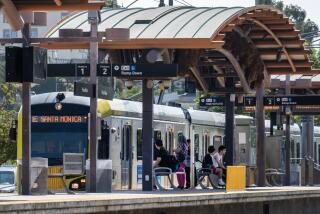RTD Will Hand Out Tokens to Boost Ridership
More than 1 million “free sample” tokens to board RTD buses will be distributed across the county in the coming months--a gamble that could cost the financially troubled transit district several hundred thousand dollars or generate millions in new revenue by reversing a decline in ridership.
The new marketing program, which the Southern California Rapid Transit District board endorsed Thursday, is the first of its type for the district and a response to a three-year plunge in boardings that is expected to total 15% by the end of the current fiscal year.
Officials hope that the free tokens, which will be distributed through advertising inserts in newspapers between January and June, will attract new riders to the system and increase fare-box revenues. A concurrent advertising campaign will emphasize the savings associated with commuting by bus, officials said.
Considering Fare Hikes
The drop in fare-box income is blamed for a large share of the district’s continuing financial problems, including an $8-million shortfall in this year’s operating budget. Over the next few weeks, the RTD board will be considering possible fare hikes and bus service cutbacks to eliminate the red ink.
The free token program is expected to cost more than $300,000 in advertising and other costs, said Anthony Fortuno, the RTD’s director of marketing. In addition, it could lose $440,000 or more if the tokens are used only by existing riders.
But RTD officials said the more likely result, based on similar programs in other major cities, will be an increase in ridership and up to $14 million in new fare-box income.
The RTD board endorsed the program in a 7-2 vote, although even some supporters voiced concerns. Board member Joseph Dunning said to attract and keep new riders, the district staff must increase efforts to be courteous, clean up graffiti-covered coaches and make sure buses arrive when scheduled.
Otherwise, the free token program “could backfire,” Dunning said.
Board member Nick Patsaouras was more pessimistic, predicting that the program would be a total loss.
But board member Carmen Estrada argued that the investment was a good one. “It’s a modest amount of our overall budget and we can’t continue to do nothing in the face of such an obvious shift” away from riding the RTD.
The decline in ridership has been attributed to a 1985 fare increase, cheaper gasoline prices, service that is not always reliable and loss of public confidence in the transit district because of media coverage of the agency’s problems.
The transit agency has had a bumpy track record with recent image-building, marketing campaigns. Last year, the transit district, at the height of disclosures of alleged waste and mismanagement, was criticized by the county Board of Supervisors for spending more than $56,000 on newspaper advertisements defending its performance.
Last summer, complaints forced the district to recall advertising cards it had placed on the rear of some of its buses. The signs, bearing a bus driver’s signature, read: “Sorry. If I don’t cut in front, I’ll fall behind. Thanks.”
Critics contended that the messages were too pushy and badly timed because Southern California was in the midst of a shooting spree on its highways.
More to Read
Sign up for Essential California
The most important California stories and recommendations in your inbox every morning.
You may occasionally receive promotional content from the Los Angeles Times.










